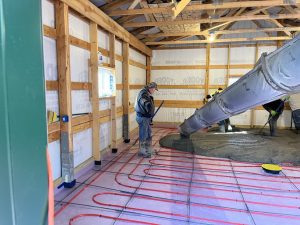When planning the administrative offices of Hansen Pole Buildings, we looked at the most efficient method to heat and cool a building which would have 8000 square feet of finished space. After weighing all of the options, it was determined the answer would be hydronic radiant floor heating, poured within the concrete floor.
 Our particular system utilizes a mixture of water and anti-freeze (propylene glycol) as the heat transfer fluid in a closed loop which is recirculated through a series of 16 wells which are 180 feet deep. There, the mixture returns to the 50-55 degree F. temperature of the below frost line ground. For summer cooling, the mixture is merely circulated through the slab. In winter, it is far easier and more efficient to use the geothermal heat pump to heat from this temperature to a comfortable room temperature, than it would be to heat outside air from 40 or more degrees below zero.
Our particular system utilizes a mixture of water and anti-freeze (propylene glycol) as the heat transfer fluid in a closed loop which is recirculated through a series of 16 wells which are 180 feet deep. There, the mixture returns to the 50-55 degree F. temperature of the below frost line ground. For summer cooling, the mixture is merely circulated through the slab. In winter, it is far easier and more efficient to use the geothermal heat pump to heat from this temperature to a comfortable room temperature, than it would be to heat outside air from 40 or more degrees below zero.
The radiant floor heating system is divided into several zones, which can be adjusted independent of each other. This allows for warmer spaces to be created in habited spaces.
Various types of pipes are available specifically for hydronic floor heating and cooling systems and are generally made from polyethylene including PEX.
Hydronic systems can use a single source or combination of energy sources to help manage energy costs. Hydronic system energy source options are boilers or heat pumps. Boilers can be powered by natural gas, coal, oil or waste oil (see https://www.econoheat.com/), electricity, solar thermal, wood or bio-fuels. Heat pumps can be electrical, natural gas, or (as in our case geothermal).
Under floor heating influences the radiant exchange by thermally conditioning the interior surfaces with low temperature long wave radiation. The heating of the surfaces suppresses body heat loss resulting in a perception of heating comfort. This general sensation of comfort is further enhanced through conduction (feet on floor) and through convection by the surface’s influence on air density. Under floor cooling works by absorbing both short wave and long wave radiation resulting in cool interior surfaces. These cool surfaces encourage the loss of body heat resulting in a perception of cooling comfort.
From a personal standpoint, the radiant floor heating and cooling in this building “just feels good” all the time. Despite at least two zones having no floor covering over the concrete, even at 40 below zero the rooms always feel warm in the winter and cool in the summer.
Under floor heating can have a positive effect on the quality of indoor air by facilitating the choice of otherwise perceived cold flooring materials such as tile, slate, terrazzo and concrete. These masonry surfaces typically have very low VOC emissions (volatile organic compounds) in comparison to other flooring options. In conjunction with moisture control, floor heating also establishes temperature conditions which are less favorable in supporting mold, bacteria and dust mites. There is recognition from the medical community relating to the benefits of floor heating especially as it relates to allergens.
Having sufficient insulation beneath the concrete floor, as well as at the perimeter of the slab is essential for ultimate system performance (R-10 expanded polystyrene (EPS) rigid insulation boards). The prediction was it would take about 48 hours to get the system up to a comfortable room temperature; however we found it to take only about eight hours.
The beauty of this system is, we can open one of the large overhead doors when it is far below zero outside….and after closing the door, the area is back to a comfortable temperature nearly immediately! And talk about HVAC efficiency. Our heating/cooling bills are amazingly low to where I can definitely vouch for the installer’s prediction of “paying for itself” is not an idle claim.






